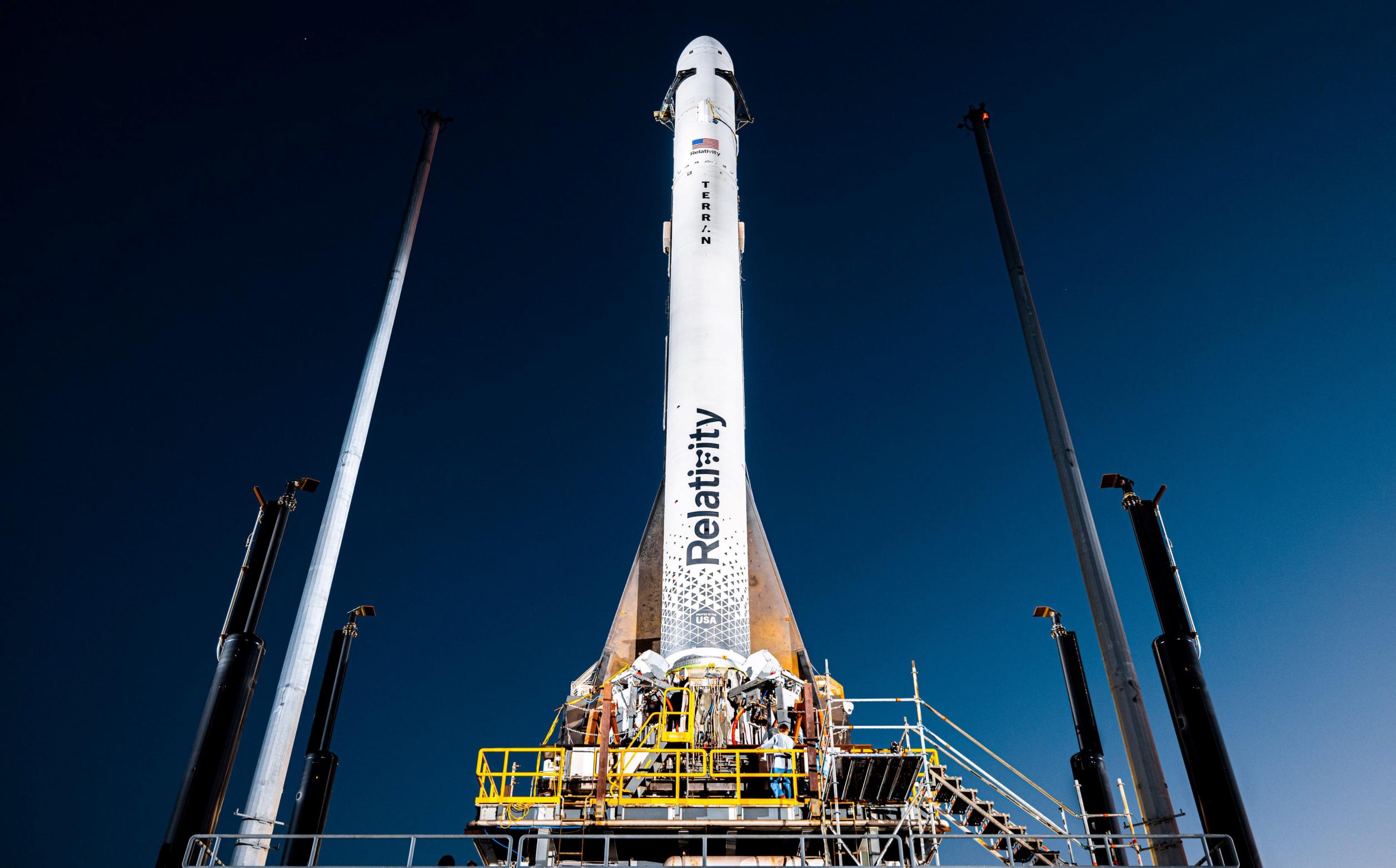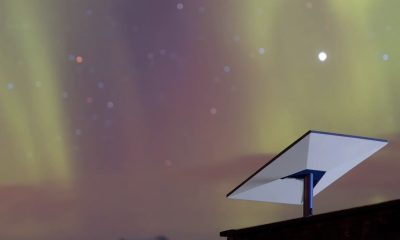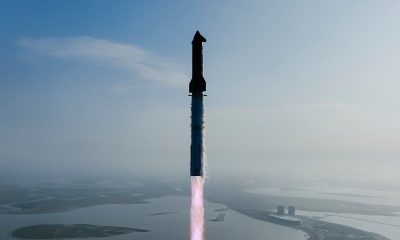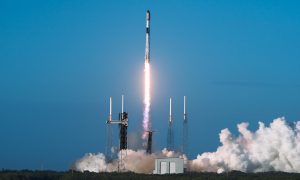

News
Relativity Space’s first 3D-printed rocket goes vertical for launch debut
Relativity Space’s first 3D-printed Terran 1 rocket has rolled out to the startup’s Florida pad and been raised vertical ahead of its launch debut.
Founded in 2015, the private Los Angeles-based spaceflight company shipped its first complete rocket prototype to Florida in June 2022. Prior to that major milestone, Relativity qualified Terran 1’s orbital second stage at leased facilities located at NASA’s Stennis Space Center in southwest Mississippi, and – alongside a nosecone and interstage – arrived at Cape Canaveral Space Force Station (CCSFS) more or less ready to fly.
The last six months have been almost exclusively dedicated to testing Terran 1’s larger and more powerful first stage (booster) as thoroughly as possible. Instead of building a dedicated booster test stand in Mississippi, Relativity chose to modify Terran 1’s lone LC-16 launch pad for the crucial task. Ultimately, the startup was able to complete a large amount of booster testing on the ground, significantly increasing the odds that Terran 1 will perform as expected when it lifts off for the first time.
The update that's rolling out to the fleet makes full use of the front and rear steering travel to minimize turning circle. In this case a reduction of 1.6 feet just over the air— Wes (@wmorrill3) April 16, 2024
Beginning with cryogenic proofing, propellant loading, ‘spin starts,’ and several shorter static fire tests, Relativity’s first Terran 1 booster test campaign culminated with two long-duration static fires in September 2022. The final 57 and 82-second static fires weren’t quite the “full mission duration” tests Relativity had hoped for, but the company concluded that the data gathered was enough to clear the booster for flight.
According to Ellis, one of the most important insights gained from those tests was into Terran 1’s uncharacteristically complex autogenous pressurization system – unprecedented for such a small rocket. Generally speaking, orbital-class rockets store helium gas in small ultra-high-pressure tanks (COPVs) and use helium to pressurize their propellant tanks as they are drained of propellant. Autogenous pressurization refers to an alternative in which a portion of a rocket’s liquid oxidizer and fuel are turned into hot gas and injected back into their respective tanks to pressurize them.
Helium is extremely expensive and an unrenewable resource. In theory, autogenous pressurization – at the cost of being significantly more complex and finicky – can also reduce the amount of dry mass reserved for tank pressurization. While Terran 1 wasn’t able to complete a full-duration static fire, the tests it did complete showed Relativity that its autogenous pressurization systems are unlikely to be a problem in flight, mostly eliminating a major source of uncertainty.
Following the final 82 or 88-second static fire, Relativity returned Terran 1’s booster to LC-16’s hangar and shifted its focus to fully assembling the two-stage rocket and finishing the launch pad. In early December, the company announced that it had fully assembled the first Terran 1. Days later, the rocket was installed on the pad’s “Transporter Erector.” The T/E responsible for transporting the rocket and raising it vertical, but it also needs to connect the rocket to ground systems (propellant, power, comms, etc.) and hold it down before liftoff.
On or around December 6th, Terran 1 rolled out to the pad and was raised vertical soon after. According to Ellis, all that stands between Terran 1 and its first launch is a short integrated static fire test and a launch license from the Federal Aviation Administration (FAA). It’s impossible to say how long the FAA will take, but it’s likely that Relativity will be technically ready to launch just a handful of weeks from now.
Beyond building a relativity impressive rocket, Relativity’s claim to fame is large-scale 3D printing. The startup says that the first Terran 1 rocket – booster, upper stage, fairing, engines, and all – is 85% 3D-printed by mass and the largest single 3D-printed object ever built. Terran 1 reportedly weighs around 9.3 tons (20,500 lb) empty; will measure around 33 meters (110 ft) tall and 2.3 meters (7.5 ft) wide; and will produce around 90 tons (~200,000 lbf) of thrust at liftoff. The rocket is designed to launch 1.25 tons (~2750 lb) to low Earth orbit for $12 million
News
Tesla begins Robotaxi certification push in Arizona: report
Tesla seems serious about expanding its Robotaxi service to several states in the coming months.

Tesla has initiated discussions with Arizona transportation regulators to certify its driverless Robotaxi service in the state, as per a recent report from Bloomberg News. The move follows Tesla’s launch of its Robotaxi pilot program in Austin, Texas, as well as CEO Elon Musk’s recent comments about the service’s expansion in the Bay Area.
The Arizona Department of Transportation confirmed to Bloomberg that Tesla has reached out to begin the certification process for autonomous ride-sharing operations in the state. While details remain limited, the outreach suggests that Tesla is serious about expanding its driverless Robotaxi service to several territories in the coming months.
The Arizona development comes as Tesla prepares to expand its service area in Austin this weekend, as per CEO Elon Musk in a post on X. Musk also stated that Tesla is targeting the San Francisco Bay Area as its next major market, with a potential launch “in a month or two,” pending regulatory approvals.
Tesla first launched its autonomous ride-hailing program on June 22 in Austin with a small fleet of Model Y vehicles, accompanied by a Tesla employee in the passenger seat to monitor safety. While still classified as a test, Musk has said the program will expand to about 1,000 vehicles in the coming months. Tesla will later upgrade its Robotaxi fleet with the Cyercab, a two-seater that is designed without a steering wheel.
Sightings of Cybercab castings around the Giga Texas complex suggests that Tesla may be ramping the initial trial production of the self-driving two-seater. Tesla, for its part, has noted in the past that volume production of the Cybercab is expected to start sometime next year.
In California, Tesla has already applied for a transportation charter-party carrier permit from the state’s Public Utilities Commission. The company is reportedly taking a phased approach to operating in California, with the Robotaxi service starting with pre-arranged rides for employees in vehicles with safety drivers.
News
Tesla sets November 6 date for 2025 Annual Shareholder Meeting
The automaker announced the date on Thursday in a Form 8-K.

Tesla has scheduled its 2025 annual shareholder meeting for November 6, addressing investor concerns that the company was nearing a legal deadline to hold the event.
The automaker announced the date on Thursday in a Form 8-K submitted to the United States Securities and Exchange Commission (SEC). The company also listed a new proposal submission deadline of July 31 for items to be included in the proxy statement.
Tesla’s announcement followed calls from a group of 27 shareholders, including the leaders of large public pension funds, which urged Tesla’s board to formally set the meeting date, as noted in a report from The Wall Street Journal.
The group noted that under Texas law, where Tesla is now incorporated, companies must hold annual meetings within 13 months of the last one if requested by shareholders. Tesla’s previous annual shareholder meeting was held on June 13, 2024, which placed the July 13 deadline in focus.
Tesla originally stated in its 2024 annual report that it would file its proxy statement by the end of April. However, an amended filing on April 30 indicated that the Board of Directors had not yet finalized a meeting date, at least at the time.
The April filing also confirmed that Tesla’s board had formed a special committee to evaluate certain matters related to CEO Elon Musk’s compensation plan. Musk’s CEO performance award remains at the center of a lengthy legal dispute in Delaware, Tesla’s former state of incorporation.
Due to the aftermath of Musk’s legal dispute about his compensation plan in Delaware, he has not been paid for his work at Tesla for several years. Musk, for his part, has noted that he is more concerned about his voting stake in Tesla than his actual salary.
At last year’s annual meeting, TSLA shareholders voted to reapprove Elon Musk’s compensation plan and ratified Tesla’s decision to relocate its legal domicile from Delaware to Texas.
Elon Musk
Grok coming to Tesla vehicles next week “at the latest:” Elon Musk
Grok’s rollout to Tesla vehicles is expected to begin next week at the latest.

Elon Musk announced on Thursday that Grok, the large language model developed by his startup xAI, will soon be available in Tesla vehicles. Grok’s rollout to Tesla vehicles is expected to begin next week at the latest, further deepening the ties between the two Elon Musk-led companies.
Tesla–xAI synergy
Musk confirmed the news on X shortly after livestreaming the release of Grok 4, xAI’s latest large language model. “Grok is coming to Tesla vehicles very soon. Next week at the latest,” Musk wrote in a post on social media platform X.
During the livestream, Musk and several members of the xAI team highlighted several upgrades to Grok 4’s voice capabilities and performance metrics, positioning the LLM as competitive with top-tier models from OpenAI and Google.
The in-vehicle integration of Grok marks a new chapter in Tesla’s AI development. While Tesla has long relied on in-house systems for autonomous driving and energy optimization, Grok’s integration would introduce conversational AI directly into its vehicles’ user experience. This integration could potentially improve customer interaction inside Tesla vehicles.
xAI and Tesla’s collaborative footprint
Grok’s upcoming rollout to Tesla vehicles adds to a growing business relationship between Tesla and xAI. Earlier this year, Tesla disclosed that it generated $198.3 million in revenue from commercial, consulting, and support agreements with xAI, as noted in a report from Bloomberg News. A large portion of that amount, however, came from the sale of Megapack energy storage systems to the artificial intelligence startup.
In July 2023, Musk polled X users about whether Tesla should invest $5 billion in xAI. While no formal investment has been made so far, 68% of poll participants voted yes, and Musk has since stated that the idea would be discussed with Tesla’s board.
-

 Elon Musk1 week ago
Elon Musk1 week agoTesla investors will be shocked by Jim Cramer’s latest assessment
-

 Elon Musk20 hours ago
Elon Musk20 hours agoxAI launches Grok 4 with new $300/month SuperGrok Heavy subscription
-

 Elon Musk3 days ago
Elon Musk3 days agoElon Musk confirms Grok 4 launch on July 9 with livestream event
-

 News7 days ago
News7 days agoTesla Model 3 ranks as the safest new car in Europe for 2025, per Euro NCAP tests
-

 Elon Musk2 weeks ago
Elon Musk2 weeks agoA Tesla just delivered itself to a customer autonomously, Elon Musk confirms
-

 Elon Musk1 week ago
Elon Musk1 week agoxAI’s Memphis data center receives air permit despite community criticism
-

 Elon Musk2 weeks ago
Elon Musk2 weeks agoTesla’s Omead Afshar, known as Elon Musk’s right-hand man, leaves company: reports
-

 News2 weeks ago
News2 weeks agoXiaomi CEO congratulates Tesla on first FSD delivery: “We have to continue learning!”

















